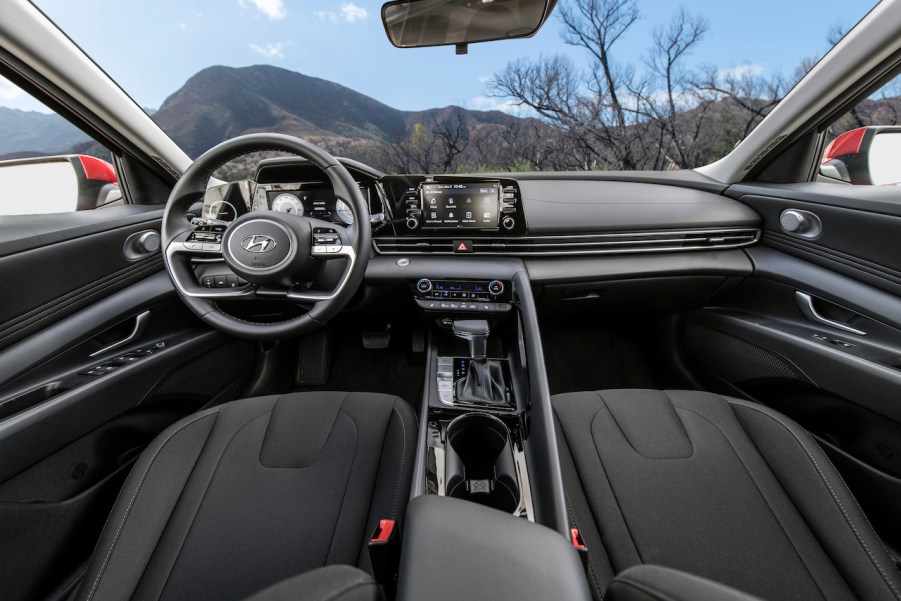
The 2021 Hyundai Elantra’s Interior Has 1 Major Drawback
The 2021 Hyundai Elantra is one of the brand’s most important products. Since the Elantra has to compete with the likes of the Honda Civic and Toyota Corolla, it has to be great. In this regard, the all-new Elantra is off to a great start, offering sharp aesthetics, powerful engine options, and an affordable price. However, the Elantra isn’t perfect, and cost-saving measures actually lead to one major interior drawback. According to Motor1, cheap materials used throughout the cabin could easily sour the overall experience.
Here’s what the 2021 Hyundai Elantra does well

The 2021 Hyundai Elantra has a lot going for it. For starters, the small sedan gets an all-new look. Regardless if it’s a love it or hate it design, it certainly is unique. As standard, you get a 147-hp 2.0-liter four-cylinder naturally aspirated engine. However, you can also opt for a 201-hp turbo four-cylinder or a 1.6-liter hybrid powertrain. As a result, The 2021 Elantra offers great engine variety. In terms of transmissions, you can choose between a CVT, a six-speed manual, or a dual-clutch automatic. However, it is important to note that the dual-clutch is only available for Hybrid and N Line models.
Aside from raw power, the Elantra offers great standard safety features. Hyundai’s SmartSense includes Forward Collision-Avoidance, Lane Keeping Assist, and Lane Following Assist, to name a few. However, if you want more, you can option extras such as Blind-Spot Collision Avoidance, Smart Cruise Control, and Highway Driving Assist. An added benefit is that moving through the trim levels doesn’t result in a significant price increase. As a result, you can opt for the exact Elantra you want without breaking the bank.
Hard plastics throughout can make the cabin feel cheap

Offering great value in an affordable car is no easy feat, and some corners need to be cut. When we look at the Hyundai Elantra’s interior quality, it begins to struggle. According to Motor1, hard plastics and cheap materials fill the cabin. Despite having a nice aesthetic, they don’t feel nice to the touch. Motor1 reports that the contact points, such as the door handle, dashboard, and center armrest, are cheap-feeling and uncomfortable.
The result is that despite the sharp aesthetics, and a large variety of standard features, the interior quickly reminds you that you’re in a cheap car. While this may not seem like a major drawback in the short term, interacting with these materials daily isn’t ideal. Additionally, even moving through the trim levels doesn’t guarantee a fix seeing as most of the interior plastics are standard across the board.
Before we get too down on the Elantra, it is important to note that other competitors in this segment also suffer from similar issues. Given the price-point, it may be worth trading off some cheap plastics in exchange for some excellent tech features.
At least there’s good tech features

If the cheap interior materials in the Hyundai Elantra don’t put you off, then you can benefit from the great interior tech. For starters, Hyundai offers an optional fully digital 10.25-inch instrument cluster. While traditional analog gauges come standard in the base SE trim, the SEL can upgrade to digital instruments. Aside from offering configurable information, the digital screen serves to modernize the cabin.
As standard, the Elantra gets an eight-inch touchscreen with Apple CarPlay and Android Auto capabilities. However, a larger 10.25-inch screen is available for the higher Limited and Limited Hybrid models. Given that the two larger screen options match up in size, they almost look like once extra widescreen when placed side by side in the dashboard. Since these are the two points, you’ll likely look at the most. It is easier to forgive the cheaper plastics in exchange for nicer tech.


